Garlic is commonly used as a seasoning worldwide but it has been used medicinally for several thousand years. Its uses were known to ancient Egyptians and where it was used as both a food flavoring and a medicine. As a medicine, it is most commonly used for conditions related to the heart and blood systems but there are many applications, both internally and externally. Garlic produces a chemical called allicin, which makes the garlic smell and seems to help with certain conditions. Some products are made “odorless” by aging the garlic, but this process can also change the effects of garlic.
People commonly use garlic internally for high blood pressure, high levels of cholesterol or other fats in the blood, and hardening of the arteries. It is also used for the common cold, osteoarthritis, and many other conditions. It is also commonly used to prevent the common cold and improving urination problems caused by an enlarged prostate.
Garlic applied to the skin can be effective in treating fungal skin infections such as ringworm, jock itch, or athlete’s foot.
Garlic Uses
- Endometriosis – a painful uterine disorder
- Atherosclerosis – hardening of the arteries
- Periodontitis – a serious gum infection
- Diabetes
- High Blood Pressure
- Ringworm
- Jock itch
- Athlete’s foot
Side Effects of Garlic
Garlic is most commonly used in food or in capsule form as a supplement. When taken orally, side effects such as bad breath, heartburn, gas, and diarrhea are not uncommon. When applied to the skin as a gel or paste, garlic could cause a severe skin irritation with some people.
Contraindications Related to Garlic
Saquinavir is a medication taken for HIV. Garlic might decrease how much saquinavir goes into the blood which may decrease the effects of saquinavir.
Garlic might slow blood clotting. Be cautious if you take any medications that also slow blood clotting.
Origins of Garlic
Central Asia and northeastern Iran.
My Favorites
- No Favorites Yet

